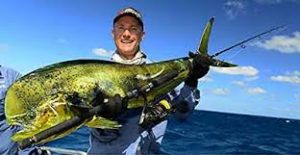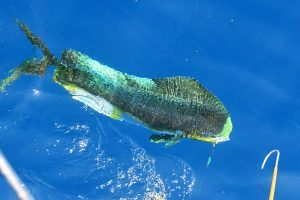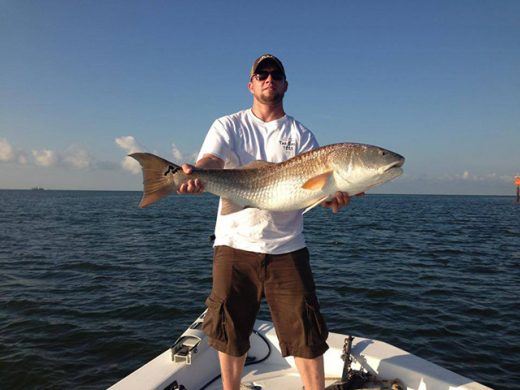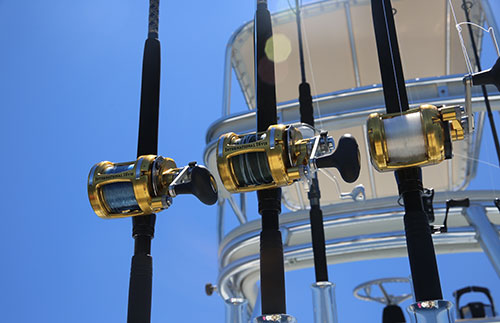Put a Spin On Mahi Fishing
Mahi fishing is great fun. It’s not only a great fish to eat but catching this fish is filled with the super action that commonly includes fish aerobatics and a great fight. Most of us usually fish for Mahi by trolling near or over structure or around weed lines. We wanted to add a spin to the usual Mahi fishing tactics, so we asked Captain Eris Jones of Sneads Ferry his thoughts on the subject. Here’s what we learned:
First, you have to know your target species. The Mahi goes by many names depending on where you are. They go by Mahi or Mahi Mahi or Dorado. They are also many times known as Dolphin. The typical Mahi reach a length of 36 inches and a weight of 15-30 pounds. Their colors are beautiful, with a combination of green, yellow and gold. Out of the water the fish appears to be gold which explains the name Dorado. Upon death the colors fade to a yellow-ish gray. The long slender bodies enable them to swim at speeds up to 50 miles per hour and can easily pass your boat when hooked up.
The Mahi is a carnivore that preys upon plankton, squid, crustaceans and smaller fish. The fish matures quickly and can reach maturity between 4 and 5 months of age. The Mahi can live up to 3-4 years, but most live less than 2 years.
While trolling for Mahi is the most common means, spinning tackle can provide a more  “sportsman’s” approach. It also enables you to potentially bring more fish to the boat thanks to the Mahi’s habit of schooling and following the bigger Mahi in the school. As the Mahi gets older, the schools become smaller and eventually the school shrinks to only 2 fish.
“sportsman’s” approach. It also enables you to potentially bring more fish to the boat thanks to the Mahi’s habit of schooling and following the bigger Mahi in the school. As the Mahi gets older, the schools become smaller and eventually the school shrinks to only 2 fish.
You need to start with a 6500 or larger spinning reel with a fairly stout rod. The Mahi is both fast and strong and when hooked will produce a sudden burst of energy that can test your tackle. Recommended for this is using 80 pound line, tipped with a 25 pound leader. A small circle hook is best since the Mahi has a relatively small mouth compared to species like King Mackerel and Wahoo. The best baits are squid or even cigar minnows. Remember, the Mahi has a small mouth and they are carnivores so bait accordingly.
Now that you’re rigged up and ready to fish, it’s time to find the Mahi. You can start your search by trolling…..that’s right, trolling around offshore floating sargassum weed. This tactic will provide a quick way to get the attention of the Mahi school that could be just under the surface. Once you get a bite trolling, make sure to keep the fish on the line. Don’t bring it in the boat or release. By keep the fish hooked, many times the other Mahi in the area will come closer. Using the spinning rig bait, cast towards the floating structure taking care to not get snagged. The Mahi can respond to a fast retrieve, so make it quick. Remember that the more you cast, the more fish. With the fish starting to congregate in the area of the first caught fish, you can also chum to keep the school close while you continue to cast and catch.

The maneuvering of the boat is important. The Mahi is both quick and has the ability to quickly change directions. It’s imperative that the captain monitors the action to make sure the hooked up fish are not getting out of position for the angler. Once the fish is close to the boat, have the gaff ready. Boat side is where your commonly lose them. When you have them in the boat, be ready for the fight to continue. Take care to maintain solid control of the Mahi. This means getting them in a fish box or cooler ASAP and make sure the lid is secured. A loose Mahi can create havoc on the crew and equipment.
Mahi fishing is fun and exciting and you can’t beat the taste of one coming off the grill on a Saturday night. With that in mind, make sure you throw a couple of spinning reels on the boat next time you head offshore. This is “fishing for Mahi with a spin”.








